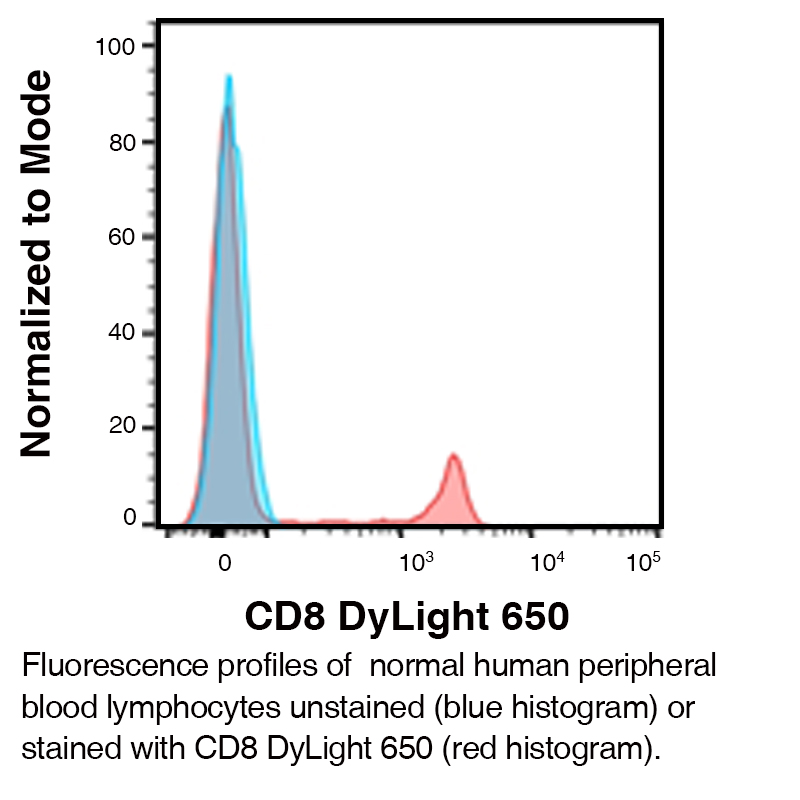Anti-Human CD8 – DyLight® 650
Anti-Human CD8 – DyLight® 650
Product No.: C2064
- -
- -
Clone UCHT-4 Target CD8 Formats AvailableView All Product Type Monoclonal Antibody Alternate Names T8, Leu2 Isotype IgG2a Applications FC |
Data
- -
- -
Antibody DetailsProduct DetailsReactive Species Human Host Species Mouse Immunogen Thymocytes and Sézary T cells Product Concentration 0.2 mg/ml Formulation This DyLight® 650 conjugate is formulated in 0.01 M phosphate buffered saline (150 mM NaCl) PBS pH 7.4, 1% BSA and 0.09% sodium azide as a preservative. Storage and Handling This DyLight® 650 conjugate is stable when stored at 2-8°C. Do not freeze. Country of Origin USA Shipping Next Day 2-8°C Excitation Laser Red Laser (652 nm) RRIDAB_2829142 Applications and Recommended Usage? Quality Tested by Leinco FC The suggested concentration for this UCHT-4 antibody for staining cells in flow cytometry is ≤ 1.0 μg per 106 cells in a volume of 100 μl or 100μl of whole blood. Titration of the reagent is recommended for optimal performance for each application. Each investigator should determine their own optimal working dilution for specific applications. See directions on lot specific datasheets, as information may periodically change. DescriptionDescriptionSpecificity Clone UCHT-4 recognizes human CD8. Background CD8 is made up of disulfide-linked α and β chains that form the α(CD8a)/β(CD8b) heterodimer and α/α homodimer. CD8 is part of the Ig superfamily that expresses primarily as CD8a homodimers. CD8a is a 32-34 kD type I glycoprotein that can also form heterodimers with CD8b. CD8 is an antigen co-receptor on T cells that mediates efficient cell to cell interactions within the immune system. CD8 coupled with the T cell receptor on the T lymphocyte recognizes an antigen displayed by an antigen presenting cell (APC) in the context of class I MHC molecules. The CD8 co-receptor also plays a role in T cell signaling by interacting with Lck (lymphocyte-specific protein tyrosine kinase) which leads to the activation of transcription factors that affect the expression of certain genes. Antigen Distribution CD8 is expressed on blood lymphocytes, a subset of NK cells, and thymocytes. Persons with HIV exhibit increased levels of CD8+ lymphocytes. Ligand/Receptor MHC Class I molecules PubMed NCBI Gene Bank ID UniProt.org Research Area Immunology References & Citations1. Parnes, J. R. et al. (1989) Adv. Immunol. 44:265
2. Reinherz, E. L. et al. (1980) J. Immunol. 124:1301
3. Fischer, A. et al. (1983) Immunology 48:177
4. Merkenschlanger, M. et al. (1988) Eur. J. Immunol. 18:1653
5. Leukocyte Typing: 3rd Workshop: Code No. 567; 4th Workshop: Code No. N31 Technical ProtocolsCertificate of Analysis |
Related Products
- -
- -
Formats Available
- -
- -
Prod No. | Description |
|---|---|
C2068 | |
C117 | |
C120 | |
C118 | |
C119 | |
C2060 | |
C2061 | |
C2062 | |
C2064 | |
C2066 | |
C366 | |
C312 | |
C666 |



